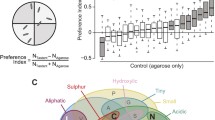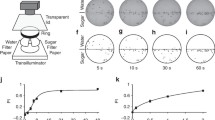Abstract
Neurons from chemosensory hairs on the galeae of adult Colorado potato beetle (CPB), Leptinotarsa decemlineata(Say), were investigated for responses to glycoalkaloids of the family Solanaceae. While solanine and tomatine elicited irregular firing by multiple neurons and bursting activity at 1 mM concentration in most sensory hairs, stimulation with leptine I resulted in consistently high-frequency, slowly adapting responses with a dose-dependent effect between 0.03 and 0.3 mM concentrations. Responses to a mixture of solanine and leptine I suggested possible modification of the leptine I response by other glycoalkaloids, resulting in reduced neural activity relative to leptine I alone. These results establish a method for specifically evaluating leptine I and other glycoalkaloids for effects on feeding behavior of CPB and provide a sensory component for incorporating deterrent chemistry into biorational control methods for the CPB.
Similar content being viewed by others
REFERENCES
CHYB, S., EICHENSEER, H., HOLLISTER, B., MULLIN, C. A., and FRAZIER, J. L. 1995. Identification of sensilla involved in taste mediation in adult western corn rootworm (Diabrotica virgifera virgiferaLeConte). J. Chem. Ecol. 21:313-329.
DICKENS, J. C. 1999. Predator-prey interactions: Olfactory adaptations of generalist and specialist predators. Agric. Forest Entomol. 1:47-54.
DICKENS, J. C. 2000. Orientation of Colorado potato beetle to natural and synthetic blends of volatiles emitted by potato plants. Agric. Forest Entomol. 2:167-172.
HARRISON, G. D., and MITCHELL, B. K. 1988. Host plant acceptance by geographic populations of the Colorado potato beetle, Leptinotarsa decemlineata: Role of solanaceous alkaloids as sensory deterrents. J. Chem. Ecol. 14:777-788.
HODGSON, E. S., LETTVIN, J. Y., and ROEDER, K. D. 1955. Physiology of a primary chemoreceptor unit. Science122:417-418.
KOWALSKI, S. P., DOMEK, J. M., DEAHL, K. L., and SANFORD, L. L. 1999. Performance of Colorado potato beetle larvae, Leptinotarsa decemlineata(Say), reared on synthetic diets supplemented with Solanumglycoalkaloids. Am. J. Potato Res. 76:305-312.
KOWALSKI, S. P., PEREZ, F. G., SANFORD, L. L., and DEAHL, K. L. 2000. Partial preparative purification of leptine I from foliage of the wild potato, Solanum chacoense(Bitt.). Prep. Biochem. Biotechnol. 30:133-144.
LAWSON, D. R., VEILLEUX, R. E., and MILLER, A. R. 1993. Biochemistry and genetics of Solanum chacoensesteroidal alkaloids: Natural resistance factors to the Colorado potato beetle. Curr. Top. Bot. Res. 1:335-352.
MESSCHENDORP, L., SMID, H. M., and VAN LOON, J. J.A. 1998. The role of an epipharyngeal sensillum in the perception of feeding deterrents by Leptinotarsa decemlineatalarvae. J. Comp. Physiol. 183:255-264.
MITCHELL, B. K. 1987. Interactions of alkaloids with galeal chemosensory cells of Colorado potato beetle. J. Chem. Ecol. 13:2009-2022.
MITCHELL, B. K. 1994. The chemosensory basis of host-plant recognition in Chrysomelidae, pp. 141-151, inP. H. Jolivet, M. L. Cox, and E. Petitpierre (eds.). Novel Aspects of the Biology of Chrysomelidae. Kluwer Academic, Dordrecht, The Netherlands.
MITCHELL, B. K., and HARRISON, G. D. 1984. Characterization of galeal chemosensilla in adult Colorado potato beetle, Leptinotarsa decemlineata. Physiol. Entomol. 9:49-56.
MITCHELL, B. K., and HARRISON, G. D. 1985. Effects of Solanumglycoalkaloids on chemosensilla in the Colorado potato beetle: A mechanism of feeding deterrence? J. Chem. Ecol. 11:73-83.
MITCHELL, B. K., and MCCASHIN, B. G. 1994. Tasting green leaf volatiles by larvae and adults of Colorado potato beetle, Leptinotarsa decemlineata. J. Chem. Ecol. 20:753-769.
MURRAY, K. D., DRUMMOND, F. A., ALFORD, A. R., STORCH, R. H., and BENTLEY, M. D. 1996. Citrus limonoid effects on Colorado potato beetle larval survival and development. Entomol. Exp. Appl. 80:503-510.
SCHOONHOVEN, L. M. 1982. Biological aspects of antifeedants. Entomol. Exp. Appl. 31:57-69.
SIKINYI, E., HANNAPEL, D. J., IMERMAN, P. M., and STAHR, H.M. 1997. Novel mechanism for resistance to Colorado potato beetle (Coleoptera: Chrysomelidae) in wild Solanumspecies. J. Econ. Entomol. 90:689-696.
SINDEN, S. L., SANFORD, L. L., CANTELO, W. M., and DEAHL, K. L. 1986. Leptine glycoalkaloids and resistance to the Colorado potato beetle (Coleoptera: Chrysomelidae) in Solanum chacoense. Environ. Entomol. 15:1057-1062.
SINDEN, S. L., SANFORD, L. L., CANTELO, W. W., and DEAHL, K. L. 1988. Bioassays of segregating plants: A strategy for studying chemical defenses. J. Chem. Ecol. 14:1941-1950.
SMITH, J. J. B., MITCHELL, B. K., ROLSETH, B. M., WHITHEAD, A. T., and ALBERT, P. J. 1990. SAPID Tools: Micro-computer programs for analysis of multi-unit nerve recordings. Chem. Senses15: 253-270.
SNEDECOR, G. W., and COCHRAN, W. G. 1967. Statistical Methods. The Iowa State University Press, Ames, Iowa, pp. 258-275.
STADLER, E., RENWICK, J. A. A., RADKE, C. D., and SACHDEV-GUPTA, K. 1995.Tarsal contact chemoreceptor response to glucosinolates and cardenolides mediating oviposition in Pieris rapae. Physiol. Entomol. 20:175-187.
STüRCKOW, B. 1959. Ñber den geschmackssinn und den tastsinn von Leptinotarsa decemlineataSay (Chrysomelidae). Z. Vergl. Physiol. 42:255-302.
STüRCKOW, B., and LöW, I. 1961. Die wirkung einiger Solanum-alkaloidglykoside auf den kartoffelkäfer, Leptinotarsa decemlineataSay. Entomol. Exp. Appl. 4:133-142.
TINGEY, W. M. 1984. Glycoalkaloids as pest resistance factors. Am. Potato J. 61:157-167.
TINGEY, W. M., and YENCHO, G. C. 1994. Insect resistance in potato: A decade of progress, pp. 405-425, inG. W. Zehnder, R. K. Jansson, M. L. Powelson, and K. V. Raman (eds.). Advances in Potato Pest Biology and Management. APS Press, St. Paul, Minnesota.
VAN LOON, J. J. A, and SCHOONHOVEN, L.M. 1999. Specialist deterrent chemoreceptors enable Pieriscaterpillars to discriminate between chemically different deterrents. Entomol. Exp. Appl. 91: 29-35.
YENCHO, G. C., KOWALSKI, S. P., KENNEDY, G. C., and SANFORD, L. L. 2000. Segregation of leptine glycoalkaloids and resistance to Colorado potato beetle (Leptinotarsa decemlineata(Say)) in F2 Solanum tuberosum(4£) £ S. chacoense(4£) potato progenies. Am. J. Potato Res. 77:167-178.
Author information
Authors and Affiliations
Rights and permissions
About this article
Cite this article
Hollister, B., Dickens, J.C., Perez, F. et al. Differential Neurosensory Responses of Adult Colorado Potato Beetle, Leptinotarsa decemlineata, to Glycoalkaloids. J Chem Ecol 27, 1105–1118 (2001). https://doi.org/10.1023/A:1010307827348
Issue Date:
DOI: https://doi.org/10.1023/A:1010307827348




